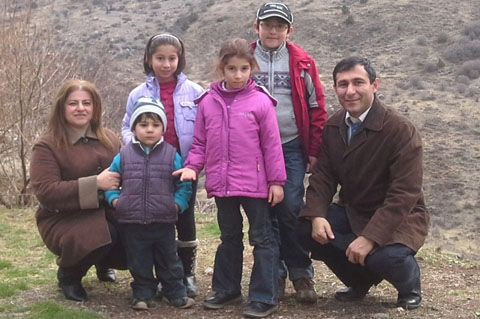The rise of Mormons in Armenia
\n
The rise of Mormons in Armenia –
\n
\n
\n
In the Armenian town of Artashat, a grid of Soviet concrete and corrugated tin roofs an hour from the capital city of Yerevan, few buildings stand out like the meeting hall of the Church of Jesus Christ of Latter-day Saints (LDS). Unlike the crumbling towers that surround it, this building sports an impeccably white façade. On one Sunday in May, more than a hundred Armenians — most in their 40s and 50s — are sharing what Mormons call spiritual “testimony,” their words translated via earpiece to attending American missionaries.
\n
Here in the Caucasus region, ethnicity and faith are often treated as one. Christians in Armenia and Georgia — which in the fourth century became the first two countries worldwide to adopt Christianity as their state religion — almost uniformly belong to the Armenian Apostolic and Georgian Orthodox Churches, respectively (93 percent in Armenia, 83 percent in Georgia).
\n
But a near-century of Soviet-imposed secularism dramatically weakened the standing of state churches. Now, many ethnic Armenians and Georgians are gravitating toward American evangelical sects with an emphasis on attracting converts and a strong missionary presence in the region, such as LDS and Jehovah’s Witnesses. In Armenia, the number of Jehovah’s Witnesses here hovers around 11,000; LDS claims more than 3,000 members (also known as Mormons). These may be small numbers, but they are significant in this country of 3 million, where practitioners of other faiths tend to be members of minority ethno-religious groups, such as Jews or Muslim Kurds.
\n
Both Jehovah’s Witnesses and Mormons identify as Christians, although their non-Trinitarian doctrine — both deny that Jesus Christ shares a single fundamental divine essence with God the Father and the Holy Spirit — has often brought them into conflict with mainline Christian tradition.
\n
“Ask any Armenian on the street and they’ll say, ‘Yes, I believe in God. I believe in Jesus,’ ” says Varuzhan Pogosyan, president of the LDS Mission in Armenia. “But they don’t always practice.”
\n
\n
\n
Varuzhan Poghosyan, right, and family
\n
\n
Pogosyan’s journey started shortly after the fall of the Soviet Union. Then an expatriate in Russia, he attended a local Armenian church, both for spiritual reasons and for the opportunity to socialize with other ethnic Armenians. But an encounter with a Mormon missionary made him realize he could do more than just attend services. “I could participate,” he says. “I could be involved in the life of the church.” In the absence of formal clergy, the LDS church offers ordinary members a greater role in church affairs, Pogosyan explains.
\n
It is this sense of involvement that inspired his colleague, Margarit Ayvazyan, to convert. Like Pogosyan, Ayvazyan grew up nonreligious during Soviet rule, adopting atheism as a philosophically inclined teenager. Yet her encounters with LDS missionaries in the early 90’s left her with a sense of spiritual fulfillment she had not found in her parents’ Armenian Apostolic services. In a traditional Armenian service, she says, “You just stand there and the priests pray.” Many Armenians cannot even understand the classical Armenian used in services. In LDS, where congregants are encouraged to share their experiences and participate in Bible-study classes, she has a role to play. Even those church members who do not become missionaries are encouraged to circulate information among family and friends, recruit curious “investigators” to visit services and keep track of lapsed members. Pogosyan says most converts here grew up like Ayvazyan: secular under the Soviet regime, but now seeking something more.
\n
In some ways, he says, their history makes his mission easier, as “Armenians have always been religious.” Soviet-era secularism was a temporary aberration, and organizations such as LDS are ideally situated to reach those whose religious needs have not been met elsewhere or who feel that the Armenian Apostolic Church has failed them. After all, in all the years since he left the Church, he’s never once been contacted by any priests trying to win him back or find out why he left: a striking contrast with the LDS church, whose members actively identify and reach out to those whose attendance has lapsed.
\n
Of course, there are challenges. Smoking, drinking and abortion were all permissible under the Soviet regime, Pogosyan says, and encouraging new converts to maintain what he calls a “healthier” way of life is a struggle. The American missionaries at Artashat tell stories of priests who attacked their brethren in neighboring towns, boys who throw rocks at them as they walk down Yerevan streets (“I think [the boys] thought we were Jehovah’s Witnesses,” one laughs. “They can’t tell the difference”).
\n
But the biggest challenge for those seeking to convert others may be reconciling converts’ faith with their ethnic identity. Many of Pogosyan’s countrymen see those who leave the Apostolic Church as less Armenian. He takes pains to emphasize the long-standing relationship between Armenia and the LDS church, which first took hold in the Armenian diaspora in 19th-century Constantinople, as well as the increasing number of foreign missionaries of Armenian descent who have come to their ancestral homeland to serve. He is also careful to stress the cultural similarities between Armenia and the LDS church. “We’re very big on family values in Armenia,” he says, making the LDS church here a perfect fit. Ultimately, his faith has made him more Armenian, not less. It has strengthened his relationship with his family, his local community. “It has made me a better citizen.”
\n
ALJAZEERA
\n


